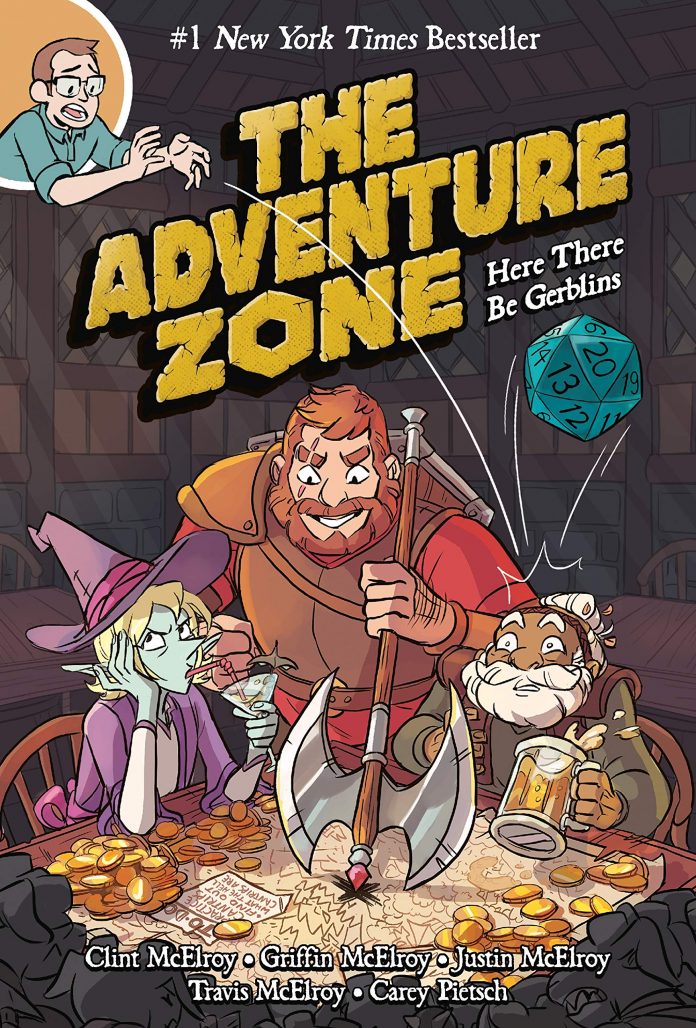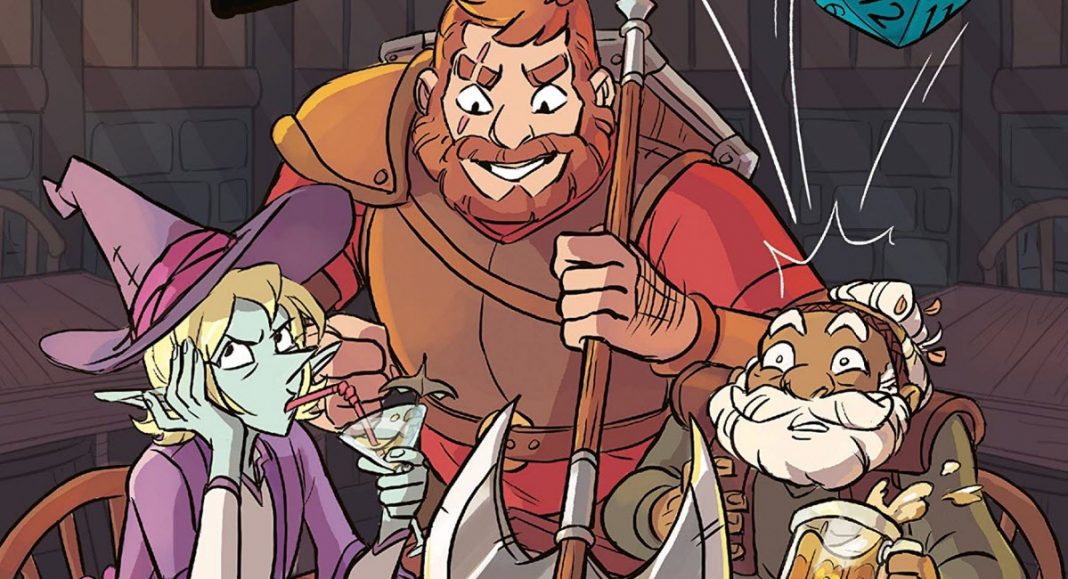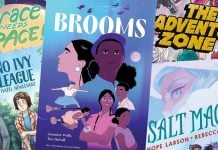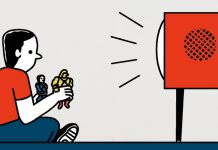
One of publisher First Second Books’s most unqualified successes has been the Adventure Zone series. The graphic novels, adapting stories from the hit podcast of the same name, have sold remarkably well, and the first book of the series landed atop the New York Times bestseller list for paperback fiction, at a time when the NYT had done away with the graphic novel bestseller list, the week it debuted. The third volume of the series written by podcast creators The McElroys (aka Clint, Griffin, Justin, and Travis McElroy) and illustrated by Carey Pietsch was released earlier this year, with a fourth due out in July of 2021.
Along with the sequential art by Pietsch, each Adventure Zone graphic novel also features pin-up art of the series characters. The first volume, Here There Be Gerblins, featured what it called a “fan art gallery” with work by nearly a dozen artists including Jonah Matteo Baumann, Liz Parlett, Johanna The Mad, and more. On Monday morning, without naming names, Baumann tweeted about his experience with the book, which included pay of only $100 for the illustration, and a clause keeping him from posting the artwork or using it in his portfolio for three years:
https://twitter.com/GalacticJonah/status/1300450671313981440
https://twitter.com/GalacticJonah/status/1300462573670760448?s=20
Shortly thereafter, another artist and a friend of Baumann’s, Iona Muresan, named (with Baumann’s permission) The Adventure Zone and First Second as who Baumann was referring to:
I-m spilling the beans The ADVENTURE ZONE, THE FREAKING MC ELROY BROTHERS, can't be bothered to pay more than 100 dollars for an illustration of their IP, A NYC best seller, i can't stress this enough, how upsetting this is when it comes to fair pay for art https://t.co/BHm7aAhu1l
— ioana Muresan @Commissions SOON (@IoanaMuresanArt) August 31, 2020
While Muresan criticized the McElroys, many pointed out that First Second would’ve been the ones responsible for contract terms for the pin-up illustrations.
Just over three hours after Baumann’s initial tweet, the McElroys responded via the official The Adventure Zone Twitter account.
Today we were made aware of the terms of contracts between artists who have been featured in The Adventure Zone graphic novels and our publisher, First Second. These artists were not adequately paid for their work, and their art was put under excessively long exclusivity clauses.
— The Adventure Zone (@TheZoneCast) August 31, 2020
We apologize for not being aware of this situation earlier, and we are urging First Second to implement these changes as soon as possible.
— The Adventure Zone (@TheZoneCast) August 31, 2020
“Today we were made aware of the terms of contracts between artists who have been featured in The Adventure Zone graphic novels and our publisher, First Second. These artists were not adequately paid for their work, and their art was put under excessively long exclusivity clauses. We are asking our publisher to lift the exclusivity terms, effective immediately, and to significantly increase the payments to artists featured in future books. We will also be compensating artists from past books an additional $500, out of pocket. We apologize for not being aware of this situation earlier, and we are urging First Second to implement these changes as soon as possible.”
Later in the day on Monday, First Second issued their own statement regarding the controversy:
A statement from the First Second team: pic.twitter.com/wL24LscGUa
— First Second Books (@01FirstSecond) August 31, 2020
“Today we received feedback about the compensation structure offered to fan artists who have contributed to The Adventure Zone graphic novel series. Our hope was to pay homage to the deep role that fan art has played in the growth of the TAZ fandom by including works from a limited number of fan artists in the books, and offering terms and compensation that were consistent with those used in the past for similar projects. The last thing we wanted was for anyone to feel that their work was undervalued—our intention was the opposite of that. We’ll be modifying the terms of the contract for all artists who have contributed to the series, as well as for all future artists who contribute. We’ll also be matching the increase the authors have committed to pay past artists for artists whose work is featured in future books. We will be in direct touch with artists about specific details.”
Some criticism had been leveled on the McElroys for not being aware of the terms of the artists’ agreements with First Second in the first place, which is fair to a point. Consider that, at this point, the McElroys are a brand unto themselves, and The Adventure Zone is another brand, and they probably have people managing licensing arrangements and all of that stuff that’s separate from them making their podcasts. Who knows if the McElroys themselves were even involved in the negotiations that led to The Adventure Zone becoming a graphic novel series.
Still, the swiftness with which the McElroys responded to the controversy, and with which First Second acknowledged their mistake and took steps to rectify the situation, is extremely heartening. A division of Macmillan, First Second has over the last decade or so become a preeminent destination for all-ages graphic novels feature diverse creators, characters, and genres. It’s disappointing that the terms for the pin-ups were so poor to begin with, but good to see decisive action taken correct things.
The question remains, though, why the terms within the agreement were so bad to begin with. The designation of “fan art” seems telling, as if the illustrations are somehow less official or professional than the rest of the book. While some of the artists may not have had any previous published comic credits to their name prior to Here There Be Gerblins, others like Johanna the Mad (who by the time Here There Be Gerblins was released had already been working on the BOOM! Studios series Fence for over a year) were already working professional artists who deserved to be compensated fairly for their work.
With many other high-profile creators like Gene Luen Yang, Faith Erin Hicks, Mariko Tamaki, and many more all also working regularly with First Second, one wonders if others will chime in about their experiences, or apply pressure to First Second to improve their contract terms across the board (as it sounds from their statement like those original terms are standard for them). At the very least, the kerfuffle around artist compensation for work on The Adventure Zone books will hopefully lead to a larger industry discussion about how artists — particularly younger, less experienced ones — are compensated (or undercompensated, as the case may be) for their work.









But they agreed to the terms. It wasnt a surprise. This is sour grapes.
I don’t think this particular case would apply to the other artists mentioned at the end, since those are not adaptations and I’ve never seen a pin-up gallery in the back of any other First Second books.
In regards to the labeling of the gallery as “fan art,” I’d be interested whether they commissioned new art from artists that were already producing fan art or if they licensed already produced fan art.
Lastly, there are a number of reasons why artists might agree to crappy terms. That doesn’t make them less exploitative.
the terms are not “exploitative” if you agree to them.
Comments are closed.